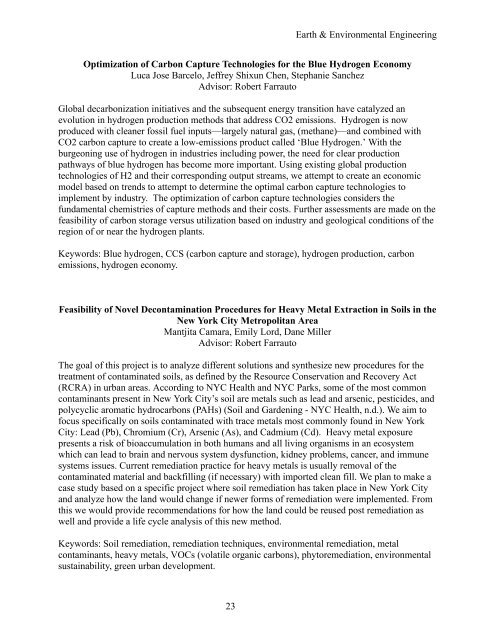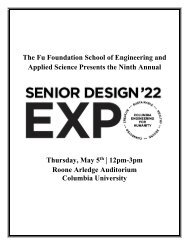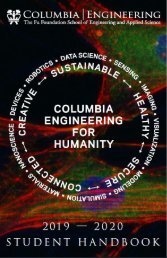You also want an ePaper? Increase the reach of your titles
YUMPU automatically turns print PDFs into web optimized ePapers that Google loves.
Earth & Environmental Engineering<br />
Optimization of Carbon Capture Technologies for the Blue Hydrogen Economy<br />
Luca Jose Barcelo, Jeffrey Shixun Chen, Stephanie Sanchez<br />
Advisor: Robert Farrauto<br />
Global decarbonization initiatives and the subsequent energy transition have catalyzed an<br />
evolution in hydrogen production methods that address CO2 emissions. Hydrogen is now<br />
produced with cleaner fossil fuel inputs—largely natural gas, (methane)—and combined with<br />
CO2 carbon capture to create a low-emissions product called ‘Blue Hydrogen.’ With the<br />
burgeoning use of hydrogen in industries including power, the need for clear production<br />
pathways of blue hydrogen has become more important. Using existing global production<br />
technologies of H2 and their corresponding output streams, we attempt to create an economic<br />
model based on trends to attempt to determine the optimal carbon capture technologies to<br />
implement by industry. The optimization of carbon capture technologies considers the<br />
fundamental chemistries of capture methods and their costs. Further assessments are made on the<br />
feasibility of carbon storage versus utilization based on industry and geological conditions of the<br />
region of or near the hydrogen plants.<br />
Keywords: Blue hydrogen, CCS (carbon capture and storage), hydrogen production, carbon<br />
emissions, hydrogen economy.<br />
Feasibility of Novel Decontamination Procedures for Heavy Metal Extraction in Soils in the<br />
New York City Metropolitan Area<br />
Mantjita Camara, Emily Lord, Dane Miller<br />
Advisor: Robert Farrauto<br />
The goal of this project is to analyze different solutions and synthesize new procedures for the<br />
treatment of contaminated soils, as defined by the Resource Conservation and Recovery Act<br />
(RCRA) in urban areas. According to NYC Health and NYC Parks, some of the most common<br />
contaminants present in New York City’s soil are metals such as lead and arsenic, pesticides, and<br />
polycyclic aromatic hydrocarbons (PAHs) (Soil and Gardening - NYC Health, n.d.). We aim to<br />
focus specifically on soils contaminated with trace metals most commonly found in New York<br />
City: Lead (Pb), Chromium (Cr), Arsenic (As), and Cadmium (Cd). Heavy metal exposure<br />
presents a risk of bioaccumulation in both humans and all living organisms in an ecosystem<br />
which can lead to brain and nervous system dysfunction, kidney problems, cancer, and immune<br />
systems issues. Current remediation practice for heavy metals is usually removal of the<br />
contaminated material and backfilling (if necessary) with imported clean fill. We plan to make a<br />
case study based on a specific project where soil remediation has taken place in New York City<br />
and analyze how the land would change if newer forms of remediation were implemented. From<br />
this we would provide recommendations for how the land could be reused post remediation as<br />
well and provide a life cycle analysis of this new method.<br />
Keywords: Soil remediation, remediation techniques, environmental remediation, metal<br />
contaminants, heavy metals, VOCs (volatile organic carbons), phytoremediation, environmental<br />
sustainability, green urban development.<br />
23








